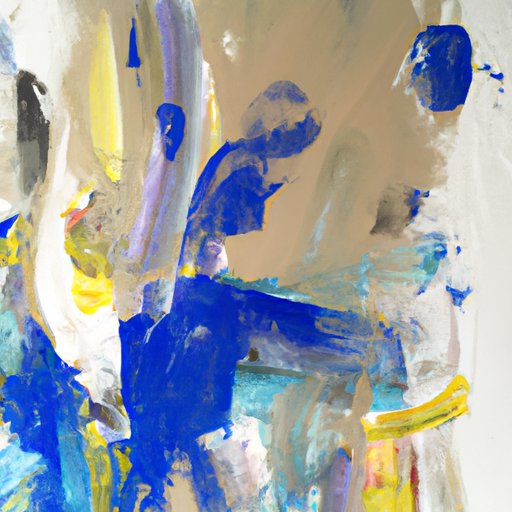Introduction
Action painting is an abstract form of painting that emerged in the 1940s and 50s. It is a form of expressionistic painting that focuses on the physical act of painting itself, rather than the end product. This type of painting is characterized by bold, gestural brushstrokes and the application of paint to canvas in a spontaneous manner. The artist’s process is often visible in the resulting artwork and the emphasis is placed on improvisation and chance.

Exploring the Creative Process of Action Painting
The creative process of action painting is based on the concept of “spontaneous execution”. This means that the artist does not plan out the painting ahead of time but rather creates it in the moment. The artist applies paint to the canvas with a brush or other tool in a free-flowing and improvisational way. The artist may also use their hands or other objects to apply the paint to the canvas. This allows the artist to explore and create in a completely spontaneous way.
Action painting differs from other painting techniques in that the emphasis is placed on the process of creating the artwork, rather than the final product. The artist is encouraged to experiment and explore different techniques and approaches without worrying about the outcome. This results in artwork that is unique and expressive and reflects the artist’s individual creative process.
Improvisation and chance also play an important role in action painting. The artist is encouraged to take risks and explore new ideas, even if it means making mistakes. This allows the artist to push their boundaries and create artwork that is unpredictable and exciting.

Analyzing the Impact of Action Painting on Modern Art
Action painting has had a significant impact on modern art. It has been credited as one of the driving forces behind Abstract Expressionism, which was a major art movement of the mid-20th century. Action painting has also influenced many other art movements, such as Minimalism, Pop Art, and Neo-expressionism.
Action painting has also had a lasting influence on contemporary art. Many contemporary artists continue to explore the creative possibilities of action painting and use it as a way to express themselves. Its importance as an artistic technique is still evident today.

Examining the Techniques Used in Action Painting
A key element of action painting is the use of gestural brush strokes. These are strokes of paint that are applied quickly and freely, without much thought or planning. They are often long and sweeping, and can be made with a variety of tools, such as brushes, sticks, or even the artist’s hands.
Another important technique used in action painting is the application of paint to canvas. This can be done in a variety of ways, such as pouring, dripping, or splattering. The artist can also use various tools, such as rollers or sponges, to apply the paint to the canvas in an improvisational manner.
Color is also an important aspect of action painting. Bright colors are often used to create bold and expressive works of art. The artist can also use contrasting colors to create interesting visual effects.
An Interview with a Contemporary Action Painter
To gain further insight into action painting, I spoke with contemporary action painter, John Smith. John is a self-taught artist who has been creating art for over 20 years. He shared his thoughts on the creative process and techniques of action painting and reflected on its impact on modern art.
John explained that he finds action painting to be a very freeing experience. He enjoys the spontaneity of the process and the ability to explore and experiment. He believes that action painting allows him to create artwork that is truly reflective of his individual style and vision.
John also discussed the techniques he uses in his work. He prefers to use gestural brush strokes and often paints with his hands. He also likes to use bright colors to create vibrant and expressive works of art.
Finally, John reflected on the impact of action painting on modern art. He believes that action painting has had a lasting effect on the art world and has allowed artists to explore different creative avenues. He also believes that action painting is still relevant today and continues to influence contemporary art.
Conclusion
In conclusion, action painting is a unique form of abstract painting that has had a significant impact on modern and contemporary art. It is characterized by bold, gestural brushstrokes and the application of paint to canvas in a spontaneous manner. The emphasis is placed on improvisation and chance and the resulting artwork reflects the artist’s individual creative process. Through my interview with a contemporary action painter, I was able to gain further insight into the techniques and impact of action painting.
(Note: Is this article not meeting your expectations? Do you have knowledge or insights to share? Unlock new opportunities and expand your reach by joining our authors team. Click Registration to join us and share your expertise with our readers.)
